Executive Summary
NFC tags are small plastic devices with embedded NFC technology that enables communication between devices. Retailers can deploy NFC tags as an inexpensive, easy way to increase engagement with their customers. Prior to a sale, retailers can use the tags to interact with shoppers in-store. Postsale, retailers can use NFC chips embedded in products to continue to engage with customers throughout a purchased product’s lifecycle.
In-Store
- Retailers can use NFC technology to interact with customers visiting their stores. Shoppers with an NFC-enabled device, such as a smartphone or tablet, can tap the NFC tag on an item they want to get more information about, and the information will appear on their device.
- Retailers can also use in-store NFC technology to create a more targeted shopping experience and showcase a wider product selection. Footwear and apparel brand Timberland and furniture retailer Made.com are two companies that have launched interactive brick-and-mortar stores where shoppers can use NFC-enabled devices to access further product information and recommendations.
Postsale
- Retailers can follow the example of many innovative brands by embedding NFC technology in private-label goods in order to engage with customers throughout a product’s lifecycle. For example, the technology can be used to send customers useful information or branded content long after they have purchased an item.
- We think that many retailers stand to benefit from thinking more like brands in their approach to private-label goods. Retailers seeking to improve shopper preference and loyalty metrics can adopt modes of engagement similar to those used by forward-thinking brands.
- Casual-fashion brand Dyne and ski and performancewear brand Spyder have introduced clothing with embedded NFC technology in order to encourage customer engagement throughout the entire product lifecycle.
NFC technology is relatively straightforward to use. Surveys show that consumers tend to prefer NFC tags over competing shopping technologies such as QR codes and beacons, and that they appreciate the speed, convenience and control that such tags provide while shopping.
Introduction
NFC tags are small plastic devices with embedded NFC technology that enables communication between devices.R etailers can gain competitive advantages by deploying NFC technology to boost engagement with customers both in-store and postsale.
In this report, we describe how NFC tags can help retailers better engage with customers, how consumers perceive their experience with NFC tags versus competing technologies and the likely impact that increased customer engagement has on retailers’ revenue growth.
We explore how Timberland and Made.com use NFC technology in their brick-and-mortar stores to better engage with shoppers, and we highlight the cases of Dyne and Spyder, two apparel companies that embed NFC tags in their garments in order to encourage customers to engage with their brands even after they leave the store.

Source: Spyder.com
We provide further details on the technical specifications of NFC tags and comparisons to other technologies in the Appendix.
NFC Tags Encourage Engagement with Customers
NFC tags provide an inexpensive, easy way for retailers to increase engagement with customers both in-store and postsale:
- In-store: Retailers can use NFC technology to interact with customers visiting their shops. Shoppers with an NFC-enabled device, such as a smartphone or tablet, can tap the NFC tag on an item to get more information about it.
- Postsale: Retailers can embed NFC technology into their own products in order to engage with customers throughout the product lifecycle. For example, the technology can be used to send customers useful information or branded content, which, in turn, can enhance the retailer’s image.
Retailers can use NFC technology to better engage with customers. In particular, NFC can help retailers:
- Boost in-store engagement: In physical stores, retailers can use NFC tags to enhance shopper engagement with a brand or item. For instance, a shopper with an NFC-enabled smartphone or tablet can scan the NFC tag on a shirt in order to see what other colors are available and receive suggestions for matching articles.
- Build engagement: NFC tags embedded in product scan encourage customers to engage with brands, including private labels. Companies can use NFC technology to deliver branded editorial content, information such as local weather conditions and links to social media posts, for example.
- Measure the impact of marketing: Retailers can also measure the impact of the messages they send to customers through NFC. For example, they can tag the links that marketing managers include in NFC tags, and then use tools such as Google Analytics to measure the impact of each marketing campaign.
- Encourage store visits and repeat purchases: Information sent by NFC tags can encourage shoppers to visit stores and create a sense of exclusivity to reward loyal customers. For example, retailers can send notifications about exclusive in-store collections to a selected group of loyal customers via NFC tags embedded in purchased items.
- Profile customers to make marketing more personal and effective: When a shopper clicks a link to a social media or transactional site that was sent via an NFC tag, retailers can capture information about that shopper’s browsing preferences. Retail and brand managers can then use that information to personalize future marketing messages directed at the individual.
There are several other technologies that retailers can adopt to better engage with shoppers in-store. In our
Deep Dive: IoT in Retail—Digitalizing Brick-and-Mortar Stores report, we listed a number of these technologies, which range from visible light communication to smart shopping carts to virtual reality. However, most of these solutions require substantial investment, whereas NFC tags have the distinct advantage of being both affordable and easy to deploy.
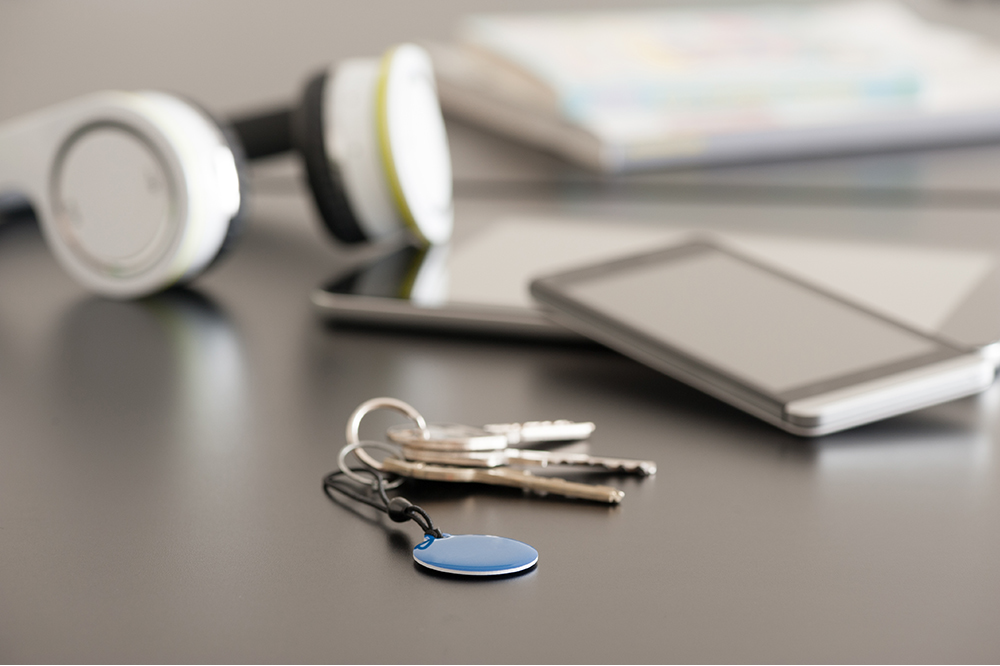
Source: iStockphoto
NFC Technology Can Help Generalist Retailers Retain Market Share
NFC technology offers retailers the opportunity to build their brands and better engage with shoppers, and it could be particularly helpful in certain hard-hit retail sectors. In the US, for instance, the difficulties faced by generalist retailers such as department stores are
well documented and have led to regular
store closure announcements. These retailers could benefit from building equity in their private-label ranges.
In the following sections, we examine the two major use cases for NFC technology in retail: in-store engagement and postsale engagement.
1. Using NFC Tags for In-Store Engagement
Brick-and-mortar retailers can use NFC tags in stores to engage more with shoppers. NFC technology can be used to create a more targeted shopping experience for each customer and to showcase a wider product selection. Below, we explore how Timberland and Made.com use NFC tags to better engage with shoppers in-store.
Timberland and Made.com
Footwear and apparel brand Timberland and furniture retailer Made.com collaborated with retail tech firm CloudTags to launch interactive brick-and-mortar stores where shoppers can use NFC-enabled devices to access further product information and recommendations.
Timberland Uses NFC to Provide Style Recommendations In-Store
Shoppers visiting Timberland’s Herald Square location in New York City can borrow NFC-enabled tablets to engage with products in the store. All items have a tag that shoppers can tap on the tablet to access content such as product information and style recommendations. Shoppers can scan products to add them to a wish list and have product details emailed to themselves.
The in-store tablets give shoppers the option to access information on the products they are interested in and, at the same time, retain control of what personal data they are sharing: since shoppers are not using their own devices, they can decide whether or not to enter personal data such as their email address.
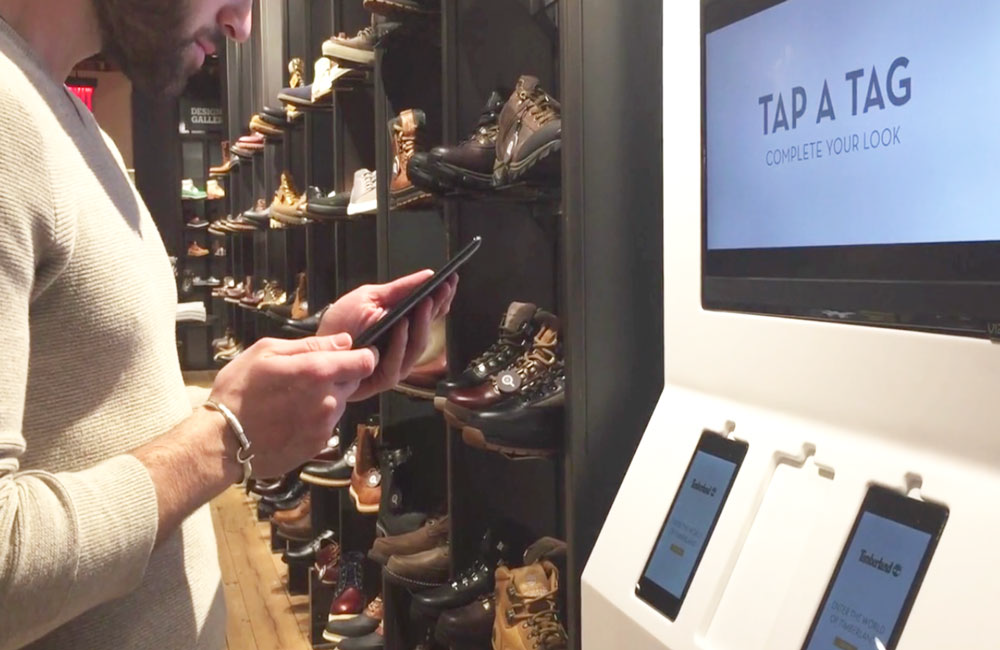
Source: CloudTags
[caption id="attachment_74332" align="alignright" width="161"]
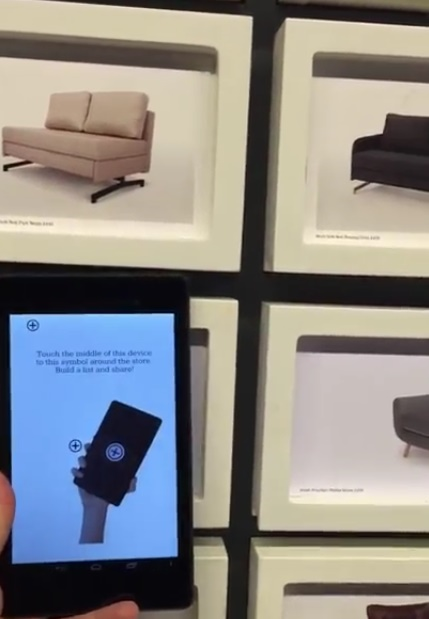
Source: YouTube[/caption]
Made.com Uses NFC to Display Items from Its Entire CataloginIts Showroom
Made.com first deployed NFC technology in its London showroom in 2014. As at the Timberland store, shoppers visiting the Made.com showroom can access product information and recommendations through tablets that are available in the store. They can tap on the NFC tags on the items displayed in-store or embedded in pictures of other products that are available through the online catalog but not stocked in the store.
Made.com originated as an online-only retailer, and its use of NFC technology allows the company to display its entire range in-store without the need to physically stock each item.
2. Adding NFC Tags to Private-Label Goods for Postsale Engagement
Retailers can think like brands in terms of using NFC technology to cultivate shopper demand and loyalty. In particular, hard-hit retailers such as department stores can embed NFC tags into private-label products such as apparel in order to engage with shoppers post-purchase. Retailers can use the technology to send customers editorial content and practical information and to engage with them on social media long after they have purchased an item.
This approach enables retailers to build stronger relationships with customers throughout the product lifecycle, which encourages brand loyalty and repeat purchases. Moreover, there is a competitive advantage for those retailers that offer an innovative type of product that rivals do not offer. In the mass market, embedding NFC technology in products may allow retailers to differentiate themselves from competitors in a way that goes beyond a simple race to the bottom on price.
We think that many retailers stand to benefit from thinking more like brands in their approach to private-label goods. Retailers can adopt similar modes of engaging customers and creating product desirability in order to boost shopper preference and loyalty. Brands such as Dyne and Spyder have adopted strategies that include embedding NFC technology into their apparel in order to improve customer engagement.
Brands Already Using NFC Tags: Dyne and Spyder
Casual-fashion firm Dyne and ski and performancewear brand Spyder collaborated with tech firm Smartrac to introduce clothing with embedded NFC technology that encourages customers to engage with the brands throughout the entire product lifecycle.
Dyne: Postsales Brand Engagement
Dyne uses NFC technology to engage with customers from purchase through the end of the product lifecycle. Dyne embeds a special NFC tag with enhanced environmental resistance developed by Smartrac into its garments. Wearers can tap the NFC tag embedded in the fabric in order to receive personalized content such as product information or to access links to lifestyle content such as streamed music via the SoundCloud app.
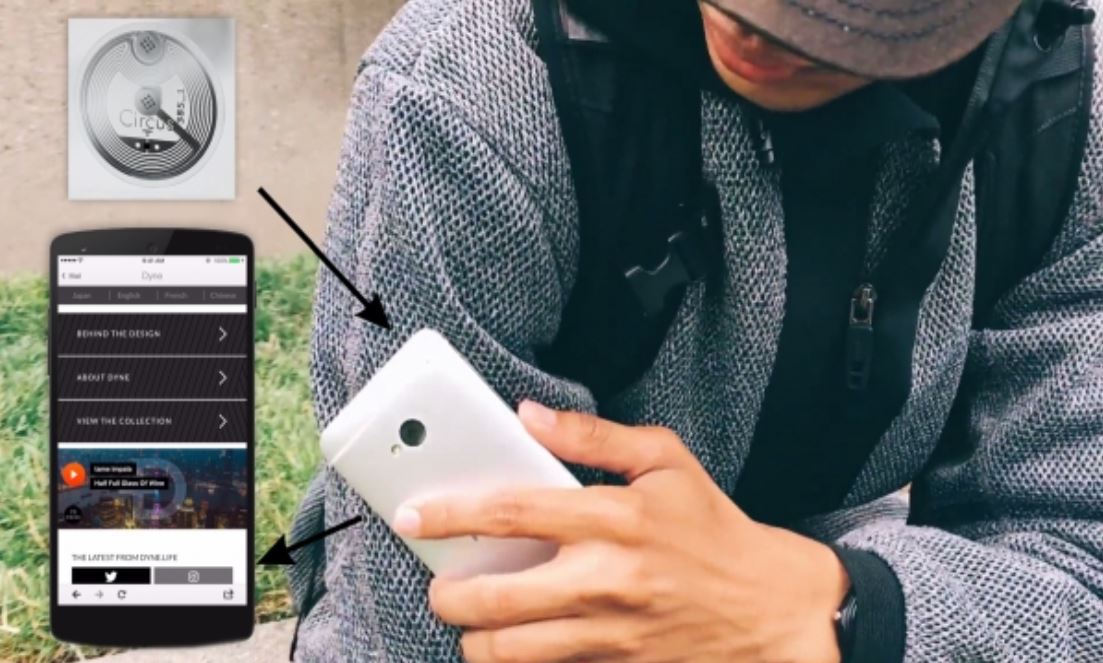
Source: Smartrac-Group.com
Spyder: NFC Turns Apparel into Experiences
Spyder, in collaboration with Li & Fung and Smartrac, launched a US Ski Team collection of NFC-enabled gear in October 2016. The line consists of items that can connect with consumer devices thanks to embedded NFC tags. The technology enables users to access location-based information such as weather and snow conditions and interact in real time on social media.

Source: Smartrac-Group.com
Consumers Favor NFC over Competing Technologies
For retailers and brand owners, implementing NFC technology is straightforward and affordable. It is also easier for shoppers to use than are competing technologies such as QR codes and Bluetooth-enabled beacons.
NFC tags enable an easy interaction between retailers and shoppers. An NFC tag transmits information immediately when a receiving device(such as a smartphone)is in proximity, without the need for the shopper to take any action to prepare the device to receive the information.
While users need only tap an NFC tag with their smartphone or tablet to access information, competing technologies such as QR codes and beacons require shoppers to take additional action in order to receive information. Specifically, shoppers must download and open a dedicated app to make use of QR codes and beacons, and they must activate Bluetooth in order to receive information via beacons.
In2014, market research firm Strategy Analytics conducted a survey of US consumers and found that those surveyed favored NFC technology over QR codes and beacons. In addition, they showed a strong interest in using NFC in both in-store and postsale scenarios. The participants in the survey indicated three significant benefits of using NFC:
- Speed: Consumers polled like the fact that NFC technology allows them to get information by simply tapping, rather than having to launch an app (which beacons require) or wait for a camera lens to focus, which is needed to scan a QR code.
- Convenience: Those surveyed said that, in real-life situations, NFC technology is the most convenient, as the technology works regardless of what other functions their smartphones are performing simultaneously.
- Control: Respondents to the survey said that NFC technology gives them more control over the information they receive, as it allows them to select which tags to tap. With beacons, by contrast, they passively receive information whenever they are in range.
Strategy Analytics conducted its survey among36 participants in the US who were asked to evaluate the use of in-store NFC, QR code and beacon technologies in different scenarios, such as accessing store deals, getting further product information, accessing a digital shopping cart and ordering related items. The results were further validated by a web survey of a larger sample of 1,038 US consumers. The table below summarizes the results of that larger survey.
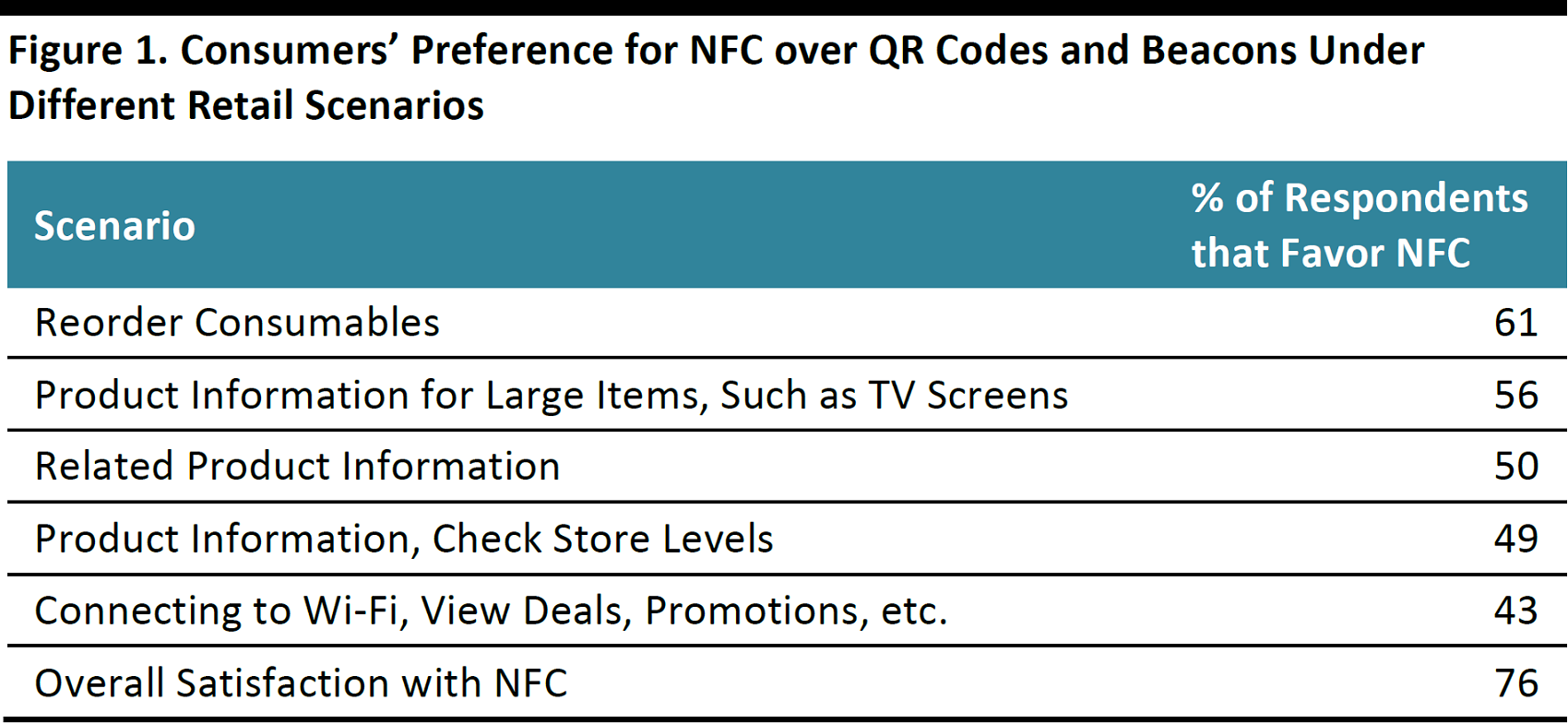
Base: 1,038 US adults
Source: Strategy Analytics
Key Takeaways: Engaging Consumers to Build Private-Label Brands
Most companies that have started using NFC tags to engage with shoppers have done so only recently, so we do not yet have concrete data on the impact of NFC-induced engagement on sales performance. However, NFC technology looks to be a convenient and affordable way to boost customer engagement. In turn, it can be used to help retailers build value in their private-label ranges. In highly competitive retail sectors, such brand building can be one way for hard-hit generalist retailers to avoid a spiral of decreasing relevance and market-share loss.
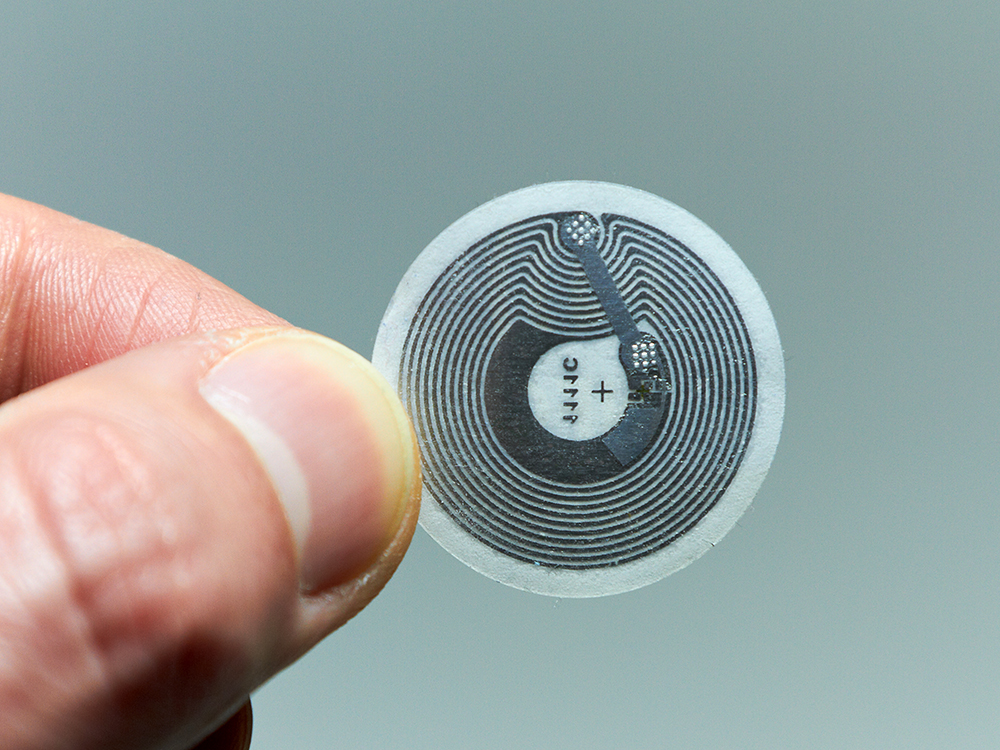
Source: iStockphoto
Appendix: NFC Technology, NFC Tags and Technical Advantages Versus Other Technologies
NFC is a short-range wireless connectivity technology that enables communication between devices. In retail, the technology is used to facilitate the transmission of information from one device to another, with two main applications:
- Payments: With NFC-enabled payment systems such as Android Pay, payment information is transmitted from an NFC chip installed in a smartphone to an NFC reader, usually located in the proximity of the point-of-sales machine.
- Customer engagement: Retailers can use NFC technology to interact with shoppers. For instance, in-store NFC devices can be used to send small pieces of information, such as links to promotional websites, to customers’ smartphones.
NFC tags are small plastic devices with embedded NFC technology. The tags send information to shoppers’ smart devices when they are in close proximity to a product with an NFC tag. The tags have very limited storage capacity—ranging from 48 bytes to 2 kilobytes—which is enough to transmit a simple piece of information, such as a link to a website. The tags have several features that make them suitable for mass adoption in retail:
- Cost: NFC tags are inexpensive. Prices vary depending on the tags’ storage capacity and the physical support, which is usually a plastic sticker or a hard plastic disk. At the time of writing, a set of 10 sticker NFC tags with 144-byte memory was available on Amazon for $7.37.
- No power requirements: NFC tags are passive devices that are activated only when an active device (such as a smartphone) comes into range. The tags are powered through electromagnetic induction coming from the active device, and so do not need an autonomous power supply to function.
- Speed: NFC tags transmit data immediately to active devices when they come into range. There is no need for shoppers to take any further action to be able to receive the information on their device.
- Supported by most smartphones: Most smartphones contain NFC chips that enable them to act as active devices that can receive information from NFC tags. Traditionally, NFC readers in iPhones did not support any type of NFC technology apart from that used in payment terminals for ApplePay. However, the iOS 11 operating system, released in September 2017, expanded NFC support by enabling the iPhone 7 and later models to read NFC chips; older iPhones such as the iPhone 6 and 6S do not have this ability.




 Source: YouTube[/caption]
Made.com Uses NFC to Display Items from Its Entire CataloginIts Showroom
Made.com first deployed NFC technology in its London showroom in 2014. As at the Timberland store, shoppers visiting the Made.com showroom can access product information and recommendations through tablets that are available in the store. They can tap on the NFC tags on the items displayed in-store or embedded in pictures of other products that are available through the online catalog but not stocked in the store.
Made.com originated as an online-only retailer, and its use of NFC technology allows the company to display its entire range in-store without the need to physically stock each item.
Source: YouTube[/caption]
Made.com Uses NFC to Display Items from Its Entire CataloginIts Showroom
Made.com first deployed NFC technology in its London showroom in 2014. As at the Timberland store, shoppers visiting the Made.com showroom can access product information and recommendations through tablets that are available in the store. They can tap on the NFC tags on the items displayed in-store or embedded in pictures of other products that are available through the online catalog but not stocked in the store.
Made.com originated as an online-only retailer, and its use of NFC technology allows the company to display its entire range in-store without the need to physically stock each item.


